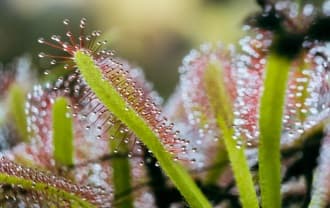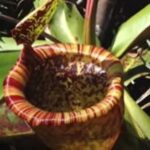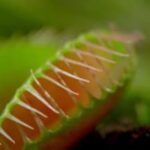As an Amazon Associate, this site earns commissions from qualifying purchases. For more details, click here.
Sundew plants (Drosera spp.) are fascinating carnivorous plants known for their unique ability to capture and digest insects. With their delicate and dew-covered tentacles, these remarkable plants have captured the interest of plant enthusiasts and hobbyists. In this guide, we will explore the basics of sundew plant cultivation, providing you with the knowledge needed to cultivate these captivating carnivores successfully.
What are Sundews?
Sundews are carnivorous plants that primarily thrive in nutrient-poor soils. They have evolved unique adaptations to supplement their nutrient intake by capturing and digesting insects. Sundews have tentacles covered in glandular hairs that produce a sticky substance, resembling dewdrops. Insects become ensnared on the sticky surface, and the plant then secretes enzymes to digest and absorb nutrients from the prey.
What Sundew Species Should You Cultivate?
There are over 200 species of sundews, each with its own specific care requirements. The “best” sundew species to grow often depends on factors such as your experience level, available growing conditions, and personal preferences. Here are some popular sundew species that are well-suited for cultivation:
Drosera capensis (Cape Sundew):
Description: Cape Sundew is one of the most forgiving and easy-to-grow sundew species. It forms rosettes of red or green leaves covered in dew-like tentacles.
Growing Conditions: It thrives in a variety of conditions, from bright indirect light to full sun. Cape Sundew is suitable for both beginners and experienced growers.
Drosera spatulata (Spoon-leaved Sundew):
Description: Spoon-leaved Sundew has small, spatula-shaped leaves covered in sticky tentacles. It is a compact and attractive species.
Growing Conditions: It prefers bright, indirect light and high humidity. It’s a great choice for terrariums or windowsills.
Drosera adelae ( Lance-leaved Sundew):
Description: Lance-leaved Sundew has long, lance-shaped leaves arranged in rosettes. It is well-known for its impressive size and unique appearance.
Growing Conditions: It thrives in high humidity and bright, indirect light. This species is suitable for intermediate to advanced growers.
Drosera binata (Fork-leaved Sundew):
Description: Fork-leaved Sundew is distinctive for its forked or divided leaves. It has a unique appearance compared to other sundew species.
Growing Conditions: It prefers full sun and can tolerate a wide range of temperatures. This species is suitable for growers with some experience.
Drosera intermedia (Spatulate-leaved Sundew):
Description: Spatulate-leaved Sundew has spoon-shaped leaves with sticky tentacles. It’s a versatile species found in a variety of habitats.
Growing Conditions: It can tolerate a range of light conditions but generally prefers bright, indirect light. This species is suitable for beginners.
Drosera adelae (Lance-leaved Sundew):
Description: Lance-leaved Sundew features lance-shaped leaves arranged in rosettes. It is known for its robust growth and striking appearance.
Growing Conditions: Provide bright, indirect light and high humidity. This species is suitable for growers with some experience.
Drosera filiformis (Thread-leaved Sundew):
Description: Thread-leaved Sundew has long, thread-like leaves with sticky tentacles. It’s well-adapted to boggy environments.
Growing Conditions: It prefers full sun and consistently moist soil. This species may be suitable for growers with some experience.
When choosing a sundew species to grow, consider your local climate, available light conditions, and your ability to provide the required care. Additionally, it’s always beneficial to research specific care guidelines for the chosen species and consult with experienced growers or nurseries for advice tailored to your specific conditions.
Choose the Right Medium
Sundews thrive in a mix of sphagnum moss or a peat-based medium. This medium retains moisture while providing the acidic conditions these plants prefer. Avoid using standard potting soil, as it may contain nutrients that can harm the sundew.
Container Selection: Choose a container with good drainage to prevent waterlogging. Hanging baskets, terrariums, or shallow pots work well for sundew cultivation
Provide Sufficient Light
Sundews typically thrive in full sunlight. If possible, place your sundews in a location where they can receive direct sunlight for several hours each day.
Indoor Growing:
If you are growing sundews indoors, choose a well-lit location with bright, indirect sunlight. A south or west-facing window is preferable. Consider using supplemental artificial light, especially if natural light is limited. LED or fluorescent lights designed for plant growth can be effective.
Artificial Grow Lights
Provide artificial lighting with a color temperature in the range of 5,000 to 6,500 Kelvin, which simulates natural sunlight. This helps mimic the light conditions that sundews thrive in. Adjust the distance between the light source and the plants to prevent burning or heat stress. Aim for a light intensity of around 2,000 to 5,000 lux.
Sundews benefit from a photoperiod of at least 12-16 hours of light each day during the growing season. Mimic the longer days of summer to encourage healthy growth.

Watering Sundews
Watering is a critical aspect of sundew plant care. Use distilled or rainwater to prevent mineral buildup. Keep the soil consistently moist but not waterlogged. Allow the top layer of the soil to dry out slightly between waterings.
Sundews naturally grow in boggy environments, and they prefer consistently moist soil. Water the plant when the top layer of the soil feels slightly dry to the touch. Avoid letting the soil dry out completely, but also prevent waterlogging, which can lead to root rot.
Watering Frequency
The frequency of watering depends on factors such as temperature, humidity, and the specific species of sundew. In general, water your sundew when the top inch (2.5 cm) of the soil feels dry. Adjust the frequency based on the plant’s response and the conditions in your growing environment.
Water the plant at the base rather than from above to simulate rain, mimicking the way sundews collect water and capture prey in their natural habitat. This helps prevent disturbing the sticky dew on the plant’s leaves.
Sundew leaves are covered in sticky hairs, and watering from above can wash away the dew, which is crucial for trapping and digesting insects. Watering at the base helps preserve the dew on the leaves.
Maintaining Humidity. Sundews thrive in humid conditions, replicating their natural habitat. Keep the humidity level around 50-60%. You can achieve this by placing a tray with water near the plants or using a humidifier.
Feeding Sundews
Sundews are capable of capturing insects on their own through their sticky tentacles. In their natural habitat, they attract and catch small insects like gnats, fruit flies, and ants. Allow the plant to capture prey naturally whenever possible.
While sundews can catch insects on their own, you can provide supplemental feeding to ensure they receive enough nutrients. This is particularly important if the growing conditions do not attract sufficient natural prey.
Offer live insects to your sundews. Suitable prey includes small flies, fruit flies, gnats, and other tiny insects. Avoid feeding them large or aggressive insects, as they might damage the delicate tentacles.
Feeding frequency. Sundews do not require frequent feeding, and overfeeding can lead to an accumulation of prey remains on the leaves. Aim to feed your sundew approximately once every 2-4 weeks, or as needed based on its growth and health.
While it might be tempting to feed sundews more frequently, excessive feeding can result in a build-up of undigested prey on the leaves, potentially leading to mold and rot. Monitor the plant’s condition and adjust the feeding frequency accordingly.
Pruning and Maintenance:
Trim away any dead or dried leaves using clean, sharp scissors or pruning shears. Dead leaves can become a breeding ground for mold and detract from the plant’s overall appearance.
Conduct regular inspections of your sundew plants to assess their overall health. Look for signs of stress, disease, or any issues with the leaves and stems.
Sundews may accumulate remains of captured prey on their leaves. Gently remove any excess prey remains to prevent mold growth and maintain the plant’s aesthetic appeal.
If your sundew has formed a clump with multiple rosettes, consider dividing them to prevent overcrowding. Gently separate the individual plants and replant them in separate pots.
Sundews can be propagated through leaf cuttings. If you wish to propagate your plant, carefully remove healthy leaves, place them in a suitable growing medium, and follow propagation guidelines.
Overwintering
Some sundew species may benefit from a period of dormancy during the winter. During this time, reduce watering and keep the plant in a cooler environment. Resume regular care in spring when new growth emerges.
Conclusion
Cultivating sundew plants can be a rewarding and educational experience. By understanding their unique characteristics and providing the right growing conditions, you can enjoy the captivating beauty of these carnivorous wonders. Remember to tailor your care routine to the specific species you are cultivating, and with patience and attention to detail, you’ll have a thriving sundew garden in no time. Happy cultivating!

My fascination with carnivorous plants began many, many years ago with Venus Fly Traps. Now I am more than happy to impart what I know with other enthusiasts and those who are curious about meat eating plants.


